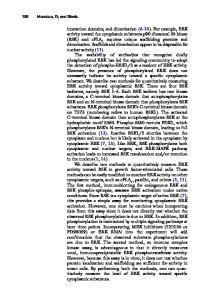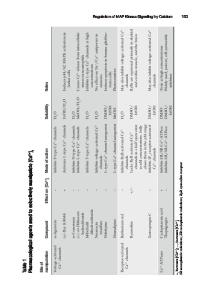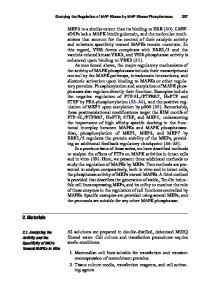Studies on MAP Kinase Signaling in the Immune System
The primary function of the immune system is to protect the organism from invading pathogens. In response to pathogen invasion, multiple signaling pathways are activated in immune cells, leading to diverse immune defense mechanisms. Chief among these path
- PDF / 1,652,825 Bytes
- 10 Pages / 504 x 720 pts Page_size
- 4 Downloads / 362 Views
1. Introduction The primary function of the immune system is to protect the organism from invading pathogens. To perform this function, the mammalian immune system has developed two components: innate immunity and adaptive immunity. Both arms of immunity recognize invading pathogens as nonself, although they utilize different receptor systems. Innate immune cells, including macrophages and dendritic cells, utilize pattern-recognition receptors (PRRs) such as Toll-like receptors (TLRs) to recognize pathogens rapidly, which provide the first line of defense against invading pathogens (1). In adaptive immunity, T and B lymphocytes recognize nonself through antigen-specific receptors, such as T-cell receptors and immunoglobulins. Adaptive immune responses are slow to develop, and therefore generally mediate protection only after several days or more postinfection.
Rony Seger (ed.), MAP Kinase Signaling Protocols: Second Edition, Methods in Molecular Biology, vol. 661, DOI 10.1007/978-1-60761-795-2_29, © Springer Science+Business Media, LLC 2010
471
472
Chi and Flavell
While pathogen recognition begins at the receptor level, it is the signaling components downstream of each receptor and the way they interact with each other that ultimately determine the specific transcriptional response and immunological outcome. Among the central pathways activated in immune cells are the MAP kinases (MAPKs), a family of serine/threonine kinases that include the extracellular signal-regulated kinases (ERK1/2), c-Jun NH2-terminal kinases (JNK-1, JNK-2, and JNK-3), p38 (p38a, p38b, p38g and p38d), and ERK5. MAPKs contain the signature sequence –TXY–, where T and Y are threonine and tyrosine, and X is glutamate, proline or glycine, in ERK, JNK, or p38, respectively (2). Phosphorylation of both the threonine and tyrosine within this signature sequence is required for MAPK activation. Phosphorylation of MAPKs is achieved via a signaling cascade involving a MAPK kinase (MAPKK or MAP2K) that is responsible for phosphorylation of the appropriate MAPK, and a MAPK kinase kinase (MAPKKK or MAP3K) that phosphorylates and activates MAPKK (2). Recent gene knockout studies have revealed that MAPKs play an important function in both the innate and adaptive immune systems. In particular, T lymphocytes (T cells), a cell type central for adaptive immunity, utilize the MAPKs for proper regulation of their development, activation and function. For example, deficiency in TAK1, a MAP3K for JNK and p38, results in impaired development, survival and homeostasis of T cells under steady-state levels, as well as diminished responses of mature T cells to antigen and cytokine stimulation (3). Combined deletion of both ERK1 and ERK2 causes defects in multiple steps of T-cell development in the thymus (4). In contrast, deficiency in JNK1 or JNK2 leads to impaired T-cell activation and differentiation (5). Given that MAPK signaling is best characterized in T cells, we center our discussions on the roles of MAPKs in the development, homeostasis, proliferation, an
Data Loading...











